Your Top 15 Must-See Places Around Iceland
Volcanic peaks, Europe’s largest glaciers, and otherworldly coastlines—Iceland is home to some of the most captivating landscapes in the world. And on a trip to Iceland, you’ll experience some of these awesome sights for yourself.
September 8, 2022
Your Top 15 Must-See Places Around Iceland
Volcanic peaks, Europe’s largest glaciers, and otherworldly coastlines—Iceland is home to some of the most captivating landscapes in the world. And on a trip to Iceland, you’ll experience some of these awesome sights for yourself.
September 8, 2022
But where to start? In this article, to help you plan your trip, you’ll discover some of the truly must-see places in Iceland. Read on for 15 of the destinations that you simply shouldn’t miss on your visit.
At Reykjavik Excursions, we make visiting Iceland’s must-see places easy. Our tours and activities in Iceland take you to all of the most popular and rewarding destinations.
What part of Iceland should I visit?
Before we get started with the list of must-see places in Iceland, let’s take a look at one of the most common questions visitors have when they come to Iceland: which part of the country should you visit?
The answer depends on the amount of time you have and your priorities for your trip.
For example, if you want to go whale-watching in Iceland, the west coast—and the distant north—will be great places to start. Alternatively, if you want to embark on a long hiking adventure, Iceland’s Highlands might be your preferred destination.
Generally, you’re very likely to start your trip to Iceland in Reykjavik, and that makes the surrounding area a great place to visit first. You can witness jaw-dropping scenery in the likes of Snæfellsnes peninsula, the Golden Circle, and the length of Iceland’s south coast.
From there, it’s easy to go much further afield. Iceland’s route 1, for example—the circular road that follows the coast of the island—is a perfect way to explore everything the country has to offer.
Now, without further ado, let’s explore the places you really shouldn’t miss.
15 must-see places in Iceland
1. Geldingadalir
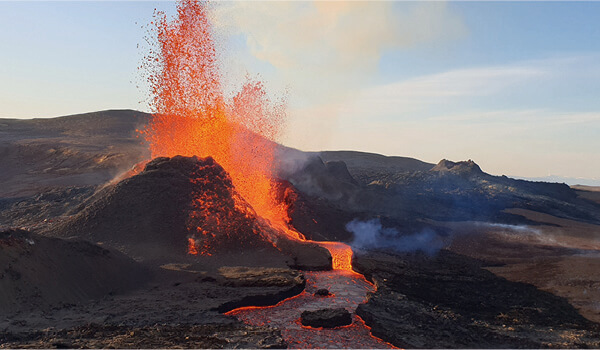
If you’re excited about Iceland’s volcanic activity, Geldingadalir should be the first destination on your list.
Iceland is one of the most volcanic regions on the planet, and Geldingadalir has recently been one of the most active volcanoes in the country. Back in 2021, the volcano at Geldingadalir erupted, attracting visitors to see its awesome display. Then, in August 2022, the same region began erupting again.
The active volcano in Geldingadalir, known as Fagradalsfjall, began to erupt when a fissure opened, releasing a few cubic kilometres of lava every second. The eruption has stopped again—for now—but it’s an incredible experience to get close to this incredible mountain nonetheless.
Luckily, it’s really conveniently located for a visit—less than an hour from Reykjavik, or half an hour from Keflavík airport.
• Read our guide to volcanoes in Iceland to discover more, or book one of our Iceland volcano tours to see it for yourself
2. The Golden Circle
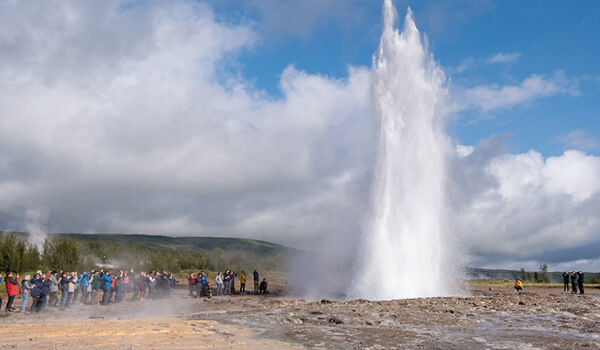
One of the best-known travel itineraries in Iceland is the Golden Circle, a journey to three of the most fascinating destinations in all of southern Iceland. Encompassing geothermal landscapes, a mighty tectonic rift, and important historic sites, it’s definitely worth your time.
The Golden Circle contains three major locations. The first is Gullfoss Waterfall, the largest waterfall by volume in Europe. With the Langjökull glacier in the distance, the striking torrent offers a truly unforgettable experience.
Then there’s the Geysir Geothermal Park, home to the Great Geyser that gave its name to the geothermal phenomenon in which hot, pressurised water shoots from the ground. It’s an incredible sight that gives you a sense of the true power of the activity beneath our feet.
Finally, the Golden Circle also includes the Þingvellir National Park, a UNESCO World Heritage Site that was once home to Iceland’s very first parliament. Now visitors come to Þingvallavatn, the largest natural lake in Iceland, formed in the Mid-Atlantic Ridge where tectonic plates have moved apart.
• Find out more in our ultimate guide to the Golden Circle in Iceland. Then book one of our Golden Circle Iceland tours.
3. Reynisfjara Black Sand Beach, South Iceland

Just outside the picturesque fishing village of Vík, you’ll find the ethereal black sands of Reynisfjara Beach. Created from volcanic rocks that characterise Iceland’s landscapes, the beach’s black sands make it an atmospheric destination that’s a favourite among photographers.
Yet it’s not just the black sand that brings visitors. Black basalt columns emerge from the water out at sea, while caves create mysterious formations in the rockface that are home to a wide variety of birds.
Reynisfjara is a 2.5 hours drive from Reykjavik on the south coast of Iceland. And it can be combined with different sights along the coast for a whole day’s experience.
• Discover more in our guide to Reynisfjara black sand beach in Iceland. Or visit Reynisfjara on our south coast tours.
4. Fjaðrárgljúfur canyon, South Iceland
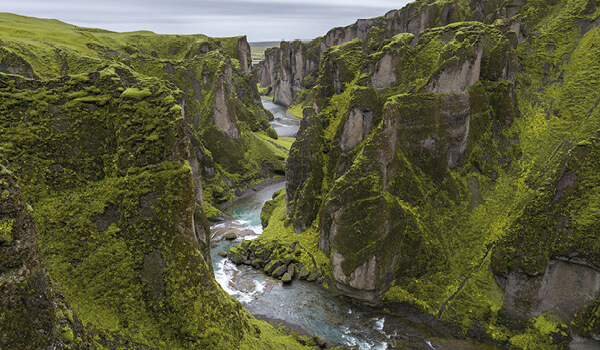
In southeast Iceland, not far from the village of Kirkjubæjarklaustur, is Fjaðrárgljúfur ("the canyon of Fjaðurá", the river that flows through it). Known for its serpentine shape and dramatic cliffs, it’s a breathtaking sight.
The beautiful canyon was formed during the Ice Age when the glaciers began to melt and dug their way down the palagonite mountain. Today the canyon is up to 100 metres (328 feet) deep.
The canyon has been growing in popularity in the last few years and Justin Bieber's video for his song “I'll Show You” made it even more popular. As a result, the canyon had to be closed for a couple of months recently, so the Icelandic Environmental Agency could fix the paths and let the area heal.
Head there in summer or winter to experience the startling power of water to create magical natural scenery.
5. Skaftafell Nature Reserve
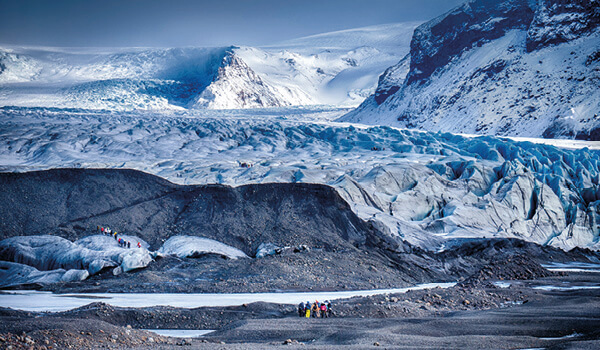
Located in the heart of the Vatnajökull National Park—one of Europe’s largest national parks—Skaftafell is home to some of the most gorgeous natural sights in southern Iceland.
It’s known primarily for its waterfalls, glaciers, and black-sand deserts. For example, hike up to Svartifoss, one of Iceland’s most characteristic waterfalls whose strange geology inspired the architecture of Hallgrimskirkja, Reykjavik’s characteristic church. Or take a guided tour across a glacier, such as Svínafellsjökull.
Skaftafell is often referred to as a hikers’ paradise, due to its incredible mix of trails and spellbinding scenery. It truly is a must-see place in Iceland, but visitors often tend to skip it for more famous sights on the south coast.
6. Jökulsárlón Glacier Lagoon, South Iceland
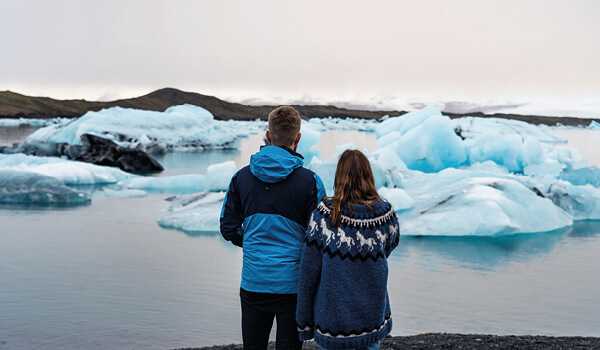
Perhaps one of the most famous sights in southern Iceland is Jökulsárlón, a glacial lagoon about a 4-hour drive from Reykjavik. Created by the melting ice of glaciers, it’s a serene, tranquil sight—and a testament to a warming world.
Today you’ll find a lake that’s about 11 square miles in size (18 square kilometres), populated by floating icebergs. Yet before the 1930s, the lake didn’t exist at all, and over the last 50 years it has quadrupled in size.
Its magic has been captured in many films over the years, including Die Another Day and Lara Croft: Tomb Raider. But there’s nothing like seeing the lagoon for yourself. Do it quickly—because, as the Breiðamerkurjökull glacier melts, the lagoon might not be there forever.
• Discover more in our guide to the Jökulsárlón glacier lagoon. Or visit Jökulsárlón on a south coast tour.
7. Diamond Beach, South Iceland

Not far from Jökulsárlón, you’ll find the Diamond Beach, a place that’s among Iceland’s most photographed sights.
You won’t find anything quite as magical anywhere else. Here, on the characteristic black sand of Iceland’s beaches, you’ll witness a scene that seems like roughly hewn diamonds scattered on the shoreline.
Believe it or not, this is actually ice, having broken off from the glacier above Jökulsárlón and drifted down to the beach. These shards of ancient compacted snow glisten in the sun before being taken out to sea.
It’s one of Iceland’s must-see places, because it’s something you won’t see anywhere else in the world.
• Discover more in our guide to the Diamond Beach in Iceland. Or visit the Diamond Beach on an Iceland south shore tour.
8. Lakagígar, Highlands of Iceland
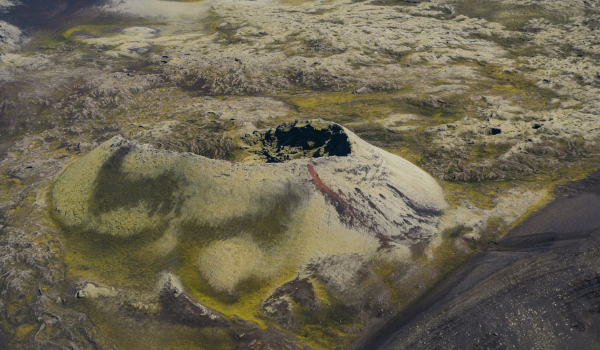
The next destination on our list of must-see places in Iceland is Lakagígar, a series of craters formed from the destruction of the Laki, one of the biggest volcanic eruptions in Iceland’s recent history.
The eruption is one of the deadliest in recent history, pouring out around 42 billion tons of basalt lava and clouds of poisonous gas. As a result, 50% of all livestock in Iceland and 25% of the Icelandic human population died. The poisonous gas went into the earth’s atmosphere which caused a drop in temperature—and crop failures—in much of the northern hemisphere.
The area is now known for its breathtaking beauty, made all the more poignant by its catastrophic history. Today, you’ll need to get there with a four-wheel drive. The adventure will be unforgettable.
9. Kerlingarfjöll, Highlands of Iceland
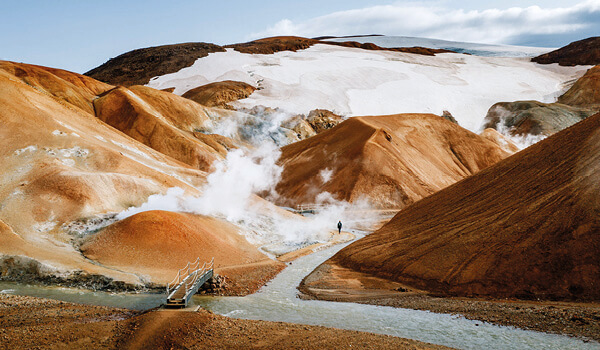
Situated in the remote Icelandic Highlands, you’ll find the mountain range known as Kerlingarfjöll. You’ll know it when you see it: this range of hills is made of red rhyolite, giving it an orange hue that’s unlike anything you’ll have seen elsewhere.
The mountain range is a modest 1,477 metres (4845 feet) tall, yet it holds a special place in Icelandic history. It’s name, for example, translates to “Our Lady Mountain”, due to a rock that appears like the body of a troll, which folklore holds was turned to stone by the sun.
The area also used to be an important hideout for bandits and other Icelanders outlawed from society. They would come to this remote spot as it’s something of an oasis in an otherwise hostile land.
That’s because of the volcanic activity in this area, evident from the many hot springs and rivulets in the surroundings. In fact, Hveradalir, where Kerlingarfjöll is situated, is the third largest volcanic area in Iceland, with geysers, fumaroles, and steam vents. Minerals from the geothermal water have coloured the ground green and yellow in some places.
The area was once a summer ski resort, but is now operated as a highland resort, with accommodation and a restaurant for guests. It's an ideal place to stop when driving the Kjölur road that crosses the Highland from south to north.
• Discover more in our guide to the Highlands of Iceland
10. Vatnajökull National Park, South Iceland
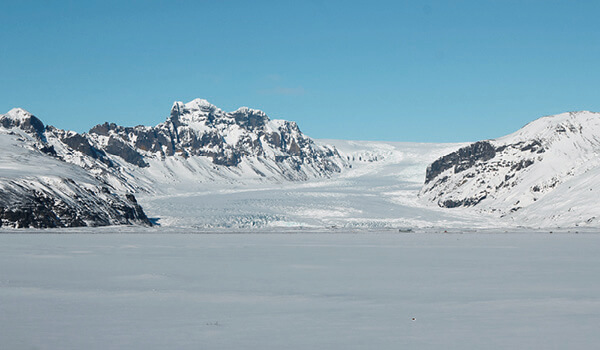
Vatnajökull National Park is simply spectacular. Covering roughly 14% of the land of Iceland, and including Vatnajökull, Europe’s largest glacier, the national park deserves its role as a UNESCO World Heritage Site.
Visitors to Iceland will find some of the country’s wildest landscapes here. To the south of the national park, you’ll see majestic mountains and the lush vegetation of Skaftafell. Further north, discover the remote highland plateau, including Snæfell and the so-called “Queen of Icelandic Mountains”, Herðubreið.
Whether by foot, off-road vehicle, or on a glacier ride, there’s so much to explore in this varied and rugged landscape.
• Go on a glacier hike in Vatnajökull National Park
11. Stuðlagil canyon, East Iceland

Often described as one of Iceland’s hidden gems, Stuðlagil is a monumental canyon situated to the east of Iceland. It still receives few visitors because of its relatively remote location. However, it really deserves many more.
Stuðlagil is formed from the waters of the mighty glacial river Jökulsá á Brú. Once, the river was known—and feared—for its powerful waters—so powerful in fact that the site remained largely unvisited.
However, as of 2009, the waters above the canyon were dammed for hydroelectric power. Now, the reduced flows have opened up the canyon for exploration.
It’s a must-see place in Iceland as it has the highest density of basalt columns in all of the country. It looks like it was carved by ancient hands.
12. Lake Mývatn, North Iceland
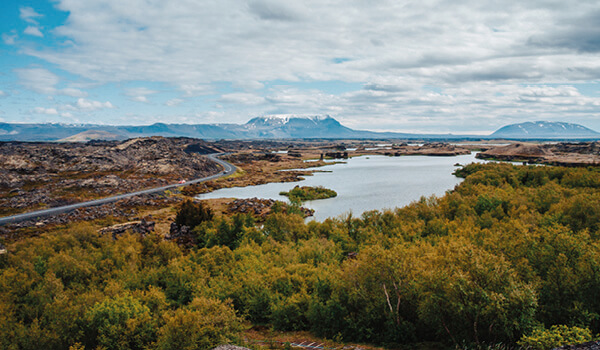
See a picture of Lake Mývatn and you’ll likely wonder what on earth it is you’re looking at. Strange craters dot the green earth around the turquoise waters of a magnificent expanse of water.
These craters are the Skútustaðagígar, more accurately known as “pseudocraters” formed when lava flowed across the wet marsh, shooting boiling water up into the air. They’re the most characteristic feature of this complex and diverse volcanic landscape—but they’re far from all there is to see.
For example, witness Dimmuborgir, the “Black Fortress”, a complex structure of cooled lava created in eruptions thousands of years ago. Or discover Ásbyrgi, a horseshoe-shaped canyon formed, it’s said, by the hoof of one of Odin’s eight-legged beasts.
Of course, Lake Mývatn is itself a jewel too, with a gorgeous variety of flora and fauna.
13. The Westfjords peninsula
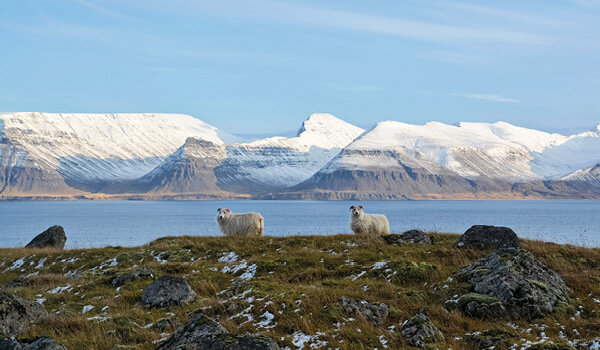
One of the least visited areas on this list, Westjord is a region known for untouched landscapes, mighty fjords, and a surprising array of wildlife.
Located at the northwestern tip of Iceland, Westfjords is also the least populated region in the country. However, if you’re up for the adventure, it’s definitely worth the trip.
The simply enormous waterfall known as Dynjandi (meaning “thunderous”) is worth a trip in itself. Or there’s Valagil, a ravine carved by an equally impressive torrent. Alternatively, on the coast, there’s Rauðasandur Beach, 10 kilometres of red sand.
But there truly is so much more to see here. Hornstrandir Nature Reserve, for example, is home to some of Iceland’s most incredible creatures, such as the Arctic fox.
14. Snæfellsnes peninsula, West Iceland

On the west coast of Iceland, between Westfjords in the north and Reykjavik in the south, sits the Snæfellsnes peninsula. Thanks to its diverse variety of landforms and sights, it’s often referred to as “Iceland in miniature”.
Kirkjufell mountain is one of the most iconic sights in the area, with its peak like the tip of an arrow. If you’re a mountain lover, there’s also Stapafell, the pyramidal mountain next to the tiny settlement of Arnarstapi.
You’ll also find black sand beaches, such as Djúpalónssandur, and ravines such as Raudfeldsgja Ravine, with its impressive waterfall.
As the peninsula juts out into the sea, Snæfellsnes is an incredible place to see marine life. Humpback whales, for example, regularly make this area their home, while seals are often seen on the beaches of Ytri Tunga.
• Discover the peninsula on a tour of the wonders of Snæfellsnes National Park.
15. Hraunfossar waterfalls
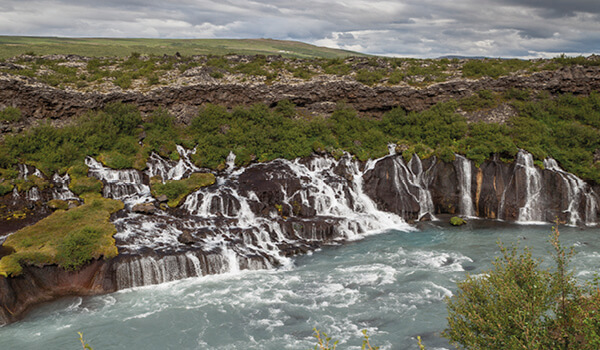
Among the many waterfalls in Iceland, one that you really must see is Hraunfossar, in western Iceland. With a name meaning “lava falls” in English, Hraunfossar is a gentle flow that seeps over the lava produced by ancient eruptions.
It’s also home to one of the largest cave systems in Iceland. A short distance from Hraunfossar, you’ll find Víðgelmir, the longest cave in the country, at a distance of over 1.5 kilometres (0.9 miles).
Further, as if to complement the gentle passage of Hraunfossar, the powerful waterfall of Barnafoss is close by, in a dramatic valley of its own.
• See the Hraunfossar waterfalls for yourself on a lava cave and geothermal adventure tour
When is the best time to go to Iceland?
The sights of Iceland are spectacular in any season. That means there really is no best time to go to Iceland. Rather, the time you choose will depend on what you want to see and do.
For example, if you want to see the magical display of the northern lights in Iceland, it’s crucial that you come to visit during the winter months. You’ll find darker nights and shorter days, but you’ll improve your chances of witnessing this breathtaking phenomenon.
However, if you want to spend your time hiking or whale-watching—or if you want to journey deep into the Highlands—the summer months may be better. Better weather and easier conditions make it a more rewarding experience.
Whichever time you decide to come to Iceland, you’ll find a warm welcome and an incredible array of must-see sights.
See Iceland’s must-see sights with Reykjavik Excursions
Come and visit the must-see places in Iceland for yourself. From black sands to lava fields and mighty glaciers, there’s nowhere that offers the range of natural sights you’ll find in Iceland.
At Reykjavik Excursions, we make seeing Iceland’s highlights easy. All you need to do is choose the destination, and we’ll ensure that you get there in comfort and style.
We can help you organise your ideal tours too. With our range of local partners, we can help you get a different perspective on Iceland, through whale-watching trips, northern lights experiences, or glacier rides.
Iceland’s must-see sights await. Explore our Iceland tours from Reykjavik to start your adventure.
Tours in the spotlight
REYKJAVIK EXCURSIONS BLOG
Get inspired! Information and tips and must see places in Iceland, fun facts, customs and more.
The Silver Circle of West Iceland - Your Guide
You’ve heard of the Golden Circle, but here’s why you should head to Iceland’s western region to explore the msytical Silver Circle tour route.
Read BlogYour Top 15 Must-See Places Around Iceland
Volcanic peaks, Europe’s largest glaciers, and otherworldly coastlines—Iceland is home to some of the most captivating landscapes in the world. And on a trip to Iceland, you’ll experience some of these awesome sights for yourself.
September 8, 2022
Your Top 15 Must-See Places Around Iceland
Volcanic peaks, Europe’s largest glaciers, and otherworldly coastlines—Iceland is home to some of the most captivating landscapes in the world. And on a trip to Iceland, you’ll experience some of these awesome sights for yourself.
September 8, 2022
But where to start? In this article, to help you plan your trip, you’ll discover some of the truly must-see places in Iceland. Read on for 15 of the destinations that you simply shouldn’t miss on your visit.
At Reykjavik Excursions, we make visiting Iceland’s must-see places easy. Our tours and activities in Iceland take you to all of the most popular and rewarding destinations.
What part of Iceland should I visit?
Before we get started with the list of must-see places in Iceland, let’s take a look at one of the most common questions visitors have when they come to Iceland: which part of the country should you visit?
The answer depends on the amount of time you have and your priorities for your trip.
For example, if you want to go whale-watching in Iceland, the west coast—and the distant north—will be great places to start. Alternatively, if you want to embark on a long hiking adventure, Iceland’s Highlands might be your preferred destination.
Generally, you’re very likely to start your trip to Iceland in Reykjavik, and that makes the surrounding area a great place to visit first. You can witness jaw-dropping scenery in the likes of Snæfellsnes peninsula, the Golden Circle, and the length of Iceland’s south coast.
From there, it’s easy to go much further afield. Iceland’s route 1, for example—the circular road that follows the coast of the island—is a perfect way to explore everything the country has to offer.
Now, without further ado, let’s explore the places you really shouldn’t miss.
15 must-see places in Iceland
1. Geldingadalir

If you’re excited about Iceland’s volcanic activity, Geldingadalir should be the first destination on your list.
Iceland is one of the most volcanic regions on the planet, and Geldingadalir has recently been one of the most active volcanoes in the country. Back in 2021, the volcano at Geldingadalir erupted, attracting visitors to see its awesome display. Then, in August 2022, the same region began erupting again.
The active volcano in Geldingadalir, known as Fagradalsfjall, began to erupt when a fissure opened, releasing a few cubic kilometres of lava every second. The eruption has stopped again—for now—but it’s an incredible experience to get close to this incredible mountain nonetheless.
Luckily, it’s really conveniently located for a visit—less than an hour from Reykjavik, or half an hour from Keflavík airport.
• Read our guide to volcanoes in Iceland to discover more, or book one of our Iceland volcano tours to see it for yourself
2. The Golden Circle

One of the best-known travel itineraries in Iceland is the Golden Circle, a journey to three of the most fascinating destinations in all of southern Iceland. Encompassing geothermal landscapes, a mighty tectonic rift, and important historic sites, it’s definitely worth your time.
The Golden Circle contains three major locations. The first is Gullfoss Waterfall, the largest waterfall by volume in Europe. With the Langjökull glacier in the distance, the striking torrent offers a truly unforgettable experience.
Then there’s the Geysir Geothermal Park, home to the Great Geyser that gave its name to the geothermal phenomenon in which hot, pressurised water shoots from the ground. It’s an incredible sight that gives you a sense of the true power of the activity beneath our feet.
Finally, the Golden Circle also includes the Þingvellir National Park, a UNESCO World Heritage Site that was once home to Iceland’s very first parliament. Now visitors come to Þingvallavatn, the largest natural lake in Iceland, formed in the Mid-Atlantic Ridge where tectonic plates have moved apart.
• Find out more in our ultimate guide to the Golden Circle in Iceland. Then book one of our Golden Circle Iceland tours.
3. Reynisfjara Black Sand Beach, South Iceland

Just outside the picturesque fishing village of Vík, you’ll find the ethereal black sands of Reynisfjara Beach. Created from volcanic rocks that characterise Iceland’s landscapes, the beach’s black sands make it an atmospheric destination that’s a favourite among photographers.
Yet it’s not just the black sand that brings visitors. Black basalt columns emerge from the water out at sea, while caves create mysterious formations in the rockface that are home to a wide variety of birds.
Reynisfjara is a 2.5 hours drive from Reykjavik on the south coast of Iceland. And it can be combined with different sights along the coast for a whole day’s experience.
• Discover more in our guide to Reynisfjara black sand beach in Iceland. Or visit Reynisfjara on our south coast tours.
4. Fjaðrárgljúfur canyon, South Iceland

In southeast Iceland, not far from the village of Kirkjubæjarklaustur, is Fjaðrárgljúfur ("the canyon of Fjaðurá", the river that flows through it). Known for its serpentine shape and dramatic cliffs, it’s a breathtaking sight.
The beautiful canyon was formed during the Ice Age when the glaciers began to melt and dug their way down the palagonite mountain. Today the canyon is up to 100 metres (328 feet) deep.
The canyon has been growing in popularity in the last few years and Justin Bieber's video for his song “I'll Show You” made it even more popular. As a result, the canyon had to be closed for a couple of months recently, so the Icelandic Environmental Agency could fix the paths and let the area heal.
Head there in summer or winter to experience the startling power of water to create magical natural scenery.
5. Skaftafell Nature Reserve

Located in the heart of the Vatnajökull National Park—one of Europe’s largest national parks—Skaftafell is home to some of the most gorgeous natural sights in southern Iceland.
It’s known primarily for its waterfalls, glaciers, and black-sand deserts. For example, hike up to Svartifoss, one of Iceland’s most characteristic waterfalls whose strange geology inspired the architecture of Hallgrimskirkja, Reykjavik’s characteristic church. Or take a guided tour across a glacier, such as Svínafellsjökull.
Skaftafell is often referred to as a hikers’ paradise, due to its incredible mix of trails and spellbinding scenery. It truly is a must-see place in Iceland, but visitors often tend to skip it for more famous sights on the south coast.
6. Jökulsárlón Glacier Lagoon, South Iceland

Perhaps one of the most famous sights in southern Iceland is Jökulsárlón, a glacial lagoon about a 4-hour drive from Reykjavik. Created by the melting ice of glaciers, it’s a serene, tranquil sight—and a testament to a warming world.
Today you’ll find a lake that’s about 11 square miles in size (18 square kilometres), populated by floating icebergs. Yet before the 1930s, the lake didn’t exist at all, and over the last 50 years it has quadrupled in size.
Its magic has been captured in many films over the years, including Die Another Day and Lara Croft: Tomb Raider. But there’s nothing like seeing the lagoon for yourself. Do it quickly—because, as the Breiðamerkurjökull glacier melts, the lagoon might not be there forever.
• Discover more in our guide to the Jökulsárlón glacier lagoon. Or visit Jökulsárlón on a south coast tour.
7. Diamond Beach, South Iceland

Not far from Jökulsárlón, you’ll find the Diamond Beach, a place that’s among Iceland’s most photographed sights.
You won’t find anything quite as magical anywhere else. Here, on the characteristic black sand of Iceland’s beaches, you’ll witness a scene that seems like roughly hewn diamonds scattered on the shoreline.
Believe it or not, this is actually ice, having broken off from the glacier above Jökulsárlón and drifted down to the beach. These shards of ancient compacted snow glisten in the sun before being taken out to sea.
It’s one of Iceland’s must-see places, because it’s something you won’t see anywhere else in the world.
• Discover more in our guide to the Diamond Beach in Iceland. Or visit the Diamond Beach on an Iceland south shore tour.
8. Lakagígar, Highlands of Iceland

The next destination on our list of must-see places in Iceland is Lakagígar, a series of craters formed from the destruction of the Laki, one of the biggest volcanic eruptions in Iceland’s recent history.
The eruption is one of the deadliest in recent history, pouring out around 42 billion tons of basalt lava and clouds of poisonous gas. As a result, 50% of all livestock in Iceland and 25% of the Icelandic human population died. The poisonous gas went into the earth’s atmosphere which caused a drop in temperature—and crop failures—in much of the northern hemisphere.
The area is now known for its breathtaking beauty, made all the more poignant by its catastrophic history. Today, you’ll need to get there with a four-wheel drive. The adventure will be unforgettable.
9. Kerlingarfjöll, Highlands of Iceland

Situated in the remote Icelandic Highlands, you’ll find the mountain range known as Kerlingarfjöll. You’ll know it when you see it: this range of hills is made of red rhyolite, giving it an orange hue that’s unlike anything you’ll have seen elsewhere.
The mountain range is a modest 1,477 metres (4845 feet) tall, yet it holds a special place in Icelandic history. It’s name, for example, translates to “Our Lady Mountain”, due to a rock that appears like the body of a troll, which folklore holds was turned to stone by the sun.
The area also used to be an important hideout for bandits and other Icelanders outlawed from society. They would come to this remote spot as it’s something of an oasis in an otherwise hostile land.
That’s because of the volcanic activity in this area, evident from the many hot springs and rivulets in the surroundings. In fact, Hveradalir, where Kerlingarfjöll is situated, is the third largest volcanic area in Iceland, with geysers, fumaroles, and steam vents. Minerals from the geothermal water have coloured the ground green and yellow in some places.
The area was once a summer ski resort, but is now operated as a highland resort, with accommodation and a restaurant for guests. It's an ideal place to stop when driving the Kjölur road that crosses the Highland from south to north.
• Discover more in our guide to the Highlands of Iceland
10. Vatnajökull National Park, South Iceland

Vatnajökull National Park is simply spectacular. Covering roughly 14% of the land of Iceland, and including Vatnajökull, Europe’s largest glacier, the national park deserves its role as a UNESCO World Heritage Site.
Visitors to Iceland will find some of the country’s wildest landscapes here. To the south of the national park, you’ll see majestic mountains and the lush vegetation of Skaftafell. Further north, discover the remote highland plateau, including Snæfell and the so-called “Queen of Icelandic Mountains”, Herðubreið.
Whether by foot, off-road vehicle, or on a glacier ride, there’s so much to explore in this varied and rugged landscape.
• Go on a glacier hike in Vatnajökull National Park
11. Stuðlagil canyon, East Iceland

Often described as one of Iceland’s hidden gems, Stuðlagil is a monumental canyon situated to the east of Iceland. It still receives few visitors because of its relatively remote location. However, it really deserves many more.
Stuðlagil is formed from the waters of the mighty glacial river Jökulsá á Brú. Once, the river was known—and feared—for its powerful waters—so powerful in fact that the site remained largely unvisited.
However, as of 2009, the waters above the canyon were dammed for hydroelectric power. Now, the reduced flows have opened up the canyon for exploration.
It’s a must-see place in Iceland as it has the highest density of basalt columns in all of the country. It looks like it was carved by ancient hands.
12. Lake Mývatn, North Iceland

See a picture of Lake Mývatn and you’ll likely wonder what on earth it is you’re looking at. Strange craters dot the green earth around the turquoise waters of a magnificent expanse of water.
These craters are the Skútustaðagígar, more accurately known as “pseudocraters” formed when lava flowed across the wet marsh, shooting boiling water up into the air. They’re the most characteristic feature of this complex and diverse volcanic landscape—but they’re far from all there is to see.
For example, witness Dimmuborgir, the “Black Fortress”, a complex structure of cooled lava created in eruptions thousands of years ago. Or discover Ásbyrgi, a horseshoe-shaped canyon formed, it’s said, by the hoof of one of Odin’s eight-legged beasts.
Of course, Lake Mývatn is itself a jewel too, with a gorgeous variety of flora and fauna.
13. The Westfjords peninsula

One of the least visited areas on this list, Westjord is a region known for untouched landscapes, mighty fjords, and a surprising array of wildlife.
Located at the northwestern tip of Iceland, Westfjords is also the least populated region in the country. However, if you’re up for the adventure, it’s definitely worth the trip.
The simply enormous waterfall known as Dynjandi (meaning “thunderous”) is worth a trip in itself. Or there’s Valagil, a ravine carved by an equally impressive torrent. Alternatively, on the coast, there’s Rauðasandur Beach, 10 kilometres of red sand.
But there truly is so much more to see here. Hornstrandir Nature Reserve, for example, is home to some of Iceland’s most incredible creatures, such as the Arctic fox.
14. Snæfellsnes peninsula, West Iceland

On the west coast of Iceland, between Westfjords in the north and Reykjavik in the south, sits the Snæfellsnes peninsula. Thanks to its diverse variety of landforms and sights, it’s often referred to as “Iceland in miniature”.
Kirkjufell mountain is one of the most iconic sights in the area, with its peak like the tip of an arrow. If you’re a mountain lover, there’s also Stapafell, the pyramidal mountain next to the tiny settlement of Arnarstapi.
You’ll also find black sand beaches, such as Djúpalónssandur, and ravines such as Raudfeldsgja Ravine, with its impressive waterfall.
As the peninsula juts out into the sea, Snæfellsnes is an incredible place to see marine life. Humpback whales, for example, regularly make this area their home, while seals are often seen on the beaches of Ytri Tunga.
• Discover the peninsula on a tour of the wonders of Snæfellsnes National Park.
15. Hraunfossar waterfalls

Among the many waterfalls in Iceland, one that you really must see is Hraunfossar, in western Iceland. With a name meaning “lava falls” in English, Hraunfossar is a gentle flow that seeps over the lava produced by ancient eruptions.
It’s also home to one of the largest cave systems in Iceland. A short distance from Hraunfossar, you’ll find Víðgelmir, the longest cave in the country, at a distance of over 1.5 kilometres (0.9 miles).
Further, as if to complement the gentle passage of Hraunfossar, the powerful waterfall of Barnafoss is close by, in a dramatic valley of its own.
• See the Hraunfossar waterfalls for yourself on a lava cave and geothermal adventure tour
When is the best time to go to Iceland?
The sights of Iceland are spectacular in any season. That means there really is no best time to go to Iceland. Rather, the time you choose will depend on what you want to see and do.
For example, if you want to see the magical display of the northern lights in Iceland, it’s crucial that you come to visit during the winter months. You’ll find darker nights and shorter days, but you’ll improve your chances of witnessing this breathtaking phenomenon.
However, if you want to spend your time hiking or whale-watching—or if you want to journey deep into the Highlands—the summer months may be better. Better weather and easier conditions make it a more rewarding experience.
Whichever time you decide to come to Iceland, you’ll find a warm welcome and an incredible array of must-see sights.
See Iceland’s must-see sights with Reykjavik Excursions
Come and visit the must-see places in Iceland for yourself. From black sands to lava fields and mighty glaciers, there’s nowhere that offers the range of natural sights you’ll find in Iceland.
At Reykjavik Excursions, we make seeing Iceland’s highlights easy. All you need to do is choose the destination, and we’ll ensure that you get there in comfort and style.
We can help you organise your ideal tours too. With our range of local partners, we can help you get a different perspective on Iceland, through whale-watching trips, northern lights experiences, or glacier rides.
Iceland’s must-see sights await. Explore our Iceland tours from Reykjavik to start your adventure.
Tours in the spotlight
REYKJAVIK EXCURSIONS BLOG
Get inspired! Information and tips and must see places in Iceland, fun facts, customs and more.
The Silver Circle of West Iceland - Your Guide
You’ve heard of the Golden Circle, but here’s why you should head to Iceland’s western region to explore the msytical Silver Circle tour route.
Read Blog